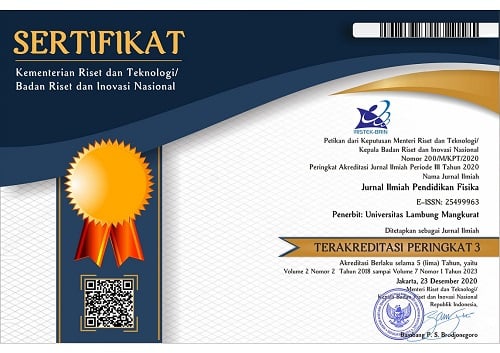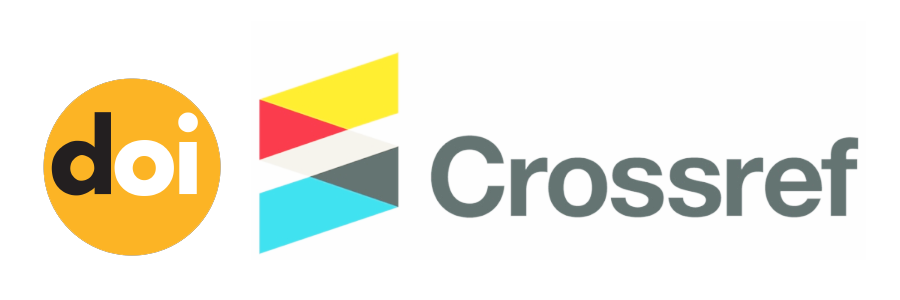Enhancing Motivation and Students’ Learning Outcomes with Orang Kayo Hitam Comic in Physics Learning
Abstract
This research is based on the low physics learning outcomes of senior high school students. This study aims to increase students' motivation and learning outcomes using Orang Kayo Hitam Comic in physics learning. The comic used for this study is based on a folktale from Jambi Province entitled Orang Kayo Hitam. The study was conducted at SMA Negeri 9 Kota Jambi, grade 10, in 2022. This kind of study is Classroom Action Research (CAR), and it is divided into three cycles. The planning, implementation, observation, and reflection stages are the four phases that make up each cycle. Based on the study results, 44% of the first cycle's students achieved the minimum qualifying score (KKM). In the second cycle, it was 56%, and in the third, it became 78%. The N-gain value of 0.4 indicates that the increase in student motivation is moderate. According to the study's findings, using Orang Kayo Hitam comic can enhance students' motivation and their learning outcomes.
Keywords
Full Text:
PDFReferences
Amiruddin, A., Nurdin, N., & Ali, Moh. (2021). Islamic education teacher communication strategy in increasing students ’learning interest. International Journal of Contemporary Islamic Education, 3(1), 41–61. https://doi.org/10.24239/ijcied.Vol3.Iss1.31
Anggraeni, W., Daulay, S., & Gafari, M. O. F. (2019). The feasibility of interactive multimedia development in children’ story of character education-based in 7th grade students of junior high school panca budi medan. Budapest International Research and Critics in Linguistics and Education (BirLE) Journal, 2(3), 164–187. https://doi.org/10.33258/birle.v2i3.363
Aprina, S. (2016). Penerapan media komik sains untuk meningkatkan hasil belajar siswa pada mata pelajaran ipa kelas iv sdn 1 ombe baru tahun pelajaran 2016/2017. Universitas Mataram.
Asriyadin, Yulianci, S., Kaniawati, I., & Liliawati, W. (2021). The formation of students’ scientific attitudes through the neuroscience-based inquiry model in physics learning. AIP Conference Proceedings, 2330(1). AIP Publishing.
https://doi.org/10.1063/5.0043348
Badeo, J. M. O., & Koc, B. C. U. O. K. (2021). Use of comic-based learning module in physics in enhancing students’ achievement and motivation. Science Education International, 32(2), 131–136. https://doi.org/10.33828/sei.v32.i2.6
Bukifan, D., & Yuliati, L. (2021, March). Conceptual understanding of physics within argument-driven inquiry learning for STEM education: Case study. AIP Conference Proceedings, 2330(1). AIP Publishing. https://doi.org/10.1063/5.0043638
Firnhammer, S. (2014). Media Systems of Japan and South Korea: A Comparative Approach.
Galili, I., & Lehavi, Y. (2006). Research report: Definitions of physical concepts: a study of physics teachers’ knowledge and views. International Journal of Science Education, 28(5), 521–541. https://doi.org/10.1080/09500690500338847
Gaol, R. L., & Sitepu, A. (2020). The influence of used good-based learning media on the value of chracter education and student’s motivation to study. Budapest International Research and Critics in Linguistics and Education (BirLE) Journal, 3(4), 1696–1703. https://doi.org/10.33258/birle.v3i4.1299
Guido, R. M. D. (2018). Attitude and motivation towards learning Physics. https://doi.org/10.48550/ARXIV.1805.02293
Hake, R. R. (1998). Interactive-engagement versus traditional methods: A six-thousand-student survey of mechanics test data for introductory physics courses. American Journal of Physics, 66(1), 64–74. https://doi.org/10.1119/1.18809
Herliandry, L. D., Harjono, A., & ’Ardhuha, J. (2018). Kemampuan berpikir kritis fisika peserta didik kelas x dengan model brain based learning. Jurnal Penelitian Pendidikan IPA, 5(1). https://doi.org/10.29303/jppipa.v5i1.166
Hidayaturrohman, R., Lesmono, A., & Prihandono, T. (2017). Pengembangan bahan ajar interaktif fisika berwawasan sets untuk meningkatkan kemampuan berpikir kritis siswa. Fkip E-Proceeding, 2, 1–9.
Kemmis, S., McTaggart, R., & Nixon, R. (2014). Introducing critical participatory action research. The Action Research Planner (pp. 1–31). Springer Singapore. https://doi.org/10.1007/978-981-4560-67-2_1
Khotimah, H., & Hidayat, N. (2022). Interactive digital comic teaching materials to increase student engagement and learning outcomes. International Journal of Elementary Education, 6(2), 245–258.
Maison, M., Haryanto, H., Wiwik Ernawati, M. D., Ningsih, Y., Jannah, N., Puspitasari, T. O., & Putra, D. S. (2020). Comparison of student attitudes towards natural sciences. International Journal of Evaluation and Research in Education (IJERE), 9(1), 54.
https://doi.org/10.11591/ijere.v9i1.20394
Murdani, E. (2020). Hakikat fisika dan keterampilan proses sains. Jurnal Filsafat Indonesia, 3(3), 72–80. https://doi.org/10.23887/jfi.v3i3.22195
Nikmah, S., Haroky, F., Jumadi, Wilujeng, I., & Kuswanto, H. (2019). Development of android comic media for the chapter of newton’s gravity to map learning motivation of students. Journal of Physics: Conference Series, 1233(1), 012051. https://doi.org/10.1088/1742-6596/1233/1/012051
Novisilta, F. C. (2016). Penggunaan media komik untuk meningkatkan minat dan hasil belajar fisika siswa kelas vii smp katolik 2 w.r. soepratman barong tongkok di kutai barat pada materi konsep zat. Universitas Sanata Dharma.
Ogunleye, A. O. (2009). Teachers and students perceptions of students problem-solving difficulties in physics: implications for remediation. Journal of College Teaching & Learning (TLC), 6(7). https://doi.org/10.19030/tlc.v6i7.1129
Pathoni̇, H., Alri̇zal, A., & Febri̇yanti̇, S. (2020). The folklore-based comic to increase Students’ motivation in physics learning. Journal for the Education of Gifted Young Scientists, 8(4), 1471–1482.
https://doi.org/10.17478/jegys.770665
Prasasti, T. I., Solin, M., & Hadi, W. (2019). The effectiveness of learning media folklore text of north sumatera based on blended learning by 10th grade students of vocational high school harapan mekar-1 medan. Budapest International Research and Critics in Linguistics and Education (BirLE) Journal, 2(4), 480–490.
https://doi.org/10.33258/birle.v2i4.548
Reshmayanti, P. I., Suarjana, I. M., & Widiana, I. W. (2022). Increasing the learning interest of fourth grade elementary school students with mission book game. Journal of Education Technology, 6(2), 277–287. https://doi.org/10.23887/jet.v6i2.46884
Rudiansyah, A., Hadromi, H., & Yudiono, H. (2021). Use of adobe flash cs 6 media in learning design skills competence modeling and building information. Journal of Vocational and Career Education, 6(1).
Sa’diyah, H., Sarwanto, S., & Sukarmin, S. (2017). Analysis of students’ difficulties on the material elasticity and harmonic oscillation in the inquiry-based physics learning in senior high school. International Journal of Science and Applied Science: Conference Series, 2(1), 139. https://doi.org/10.20961/ijsascs.v2i1.16698
Sari, F. P., Nikmah, S., Kuswanto, H., & Wardani, R. (2020). Development of physics comic based on local wisdom: Hopscotch (engklek) game android-assisted to improve mathematical representation ability and creative thinking of high school students. Revista Mexicana de Física E, 17(2 Jul-Dec), 255–262. https://doi.org/10.31349/RevMexFisE.17.255
Simanjuntak, L. Y. A., Perangin-Angin, R. B., & Saragi, D. (2019). Development of scientific based learning video media using problem based learning (pbl) model to improve student learning outcomes in 4th grade students of elementary school parmaksian, kab. sambair toba. Budapest International Research and Critics in Linguistics and Education (BirLE) Journal, 2(4), 297–304. https://doi.org/10.33258/birle.v2i4.517
Stefan, M., & Ciomoş, F. (2010). The 8th and 9th grades students’ attitude towards teaching and learning physics. Acta Didactica Napocensia, 3(3), 7–14.
Supardjo, S., Padmaningsih, D., & Sujono, S. (2020). Folk tales as a character education tool for children. Proceedings of the Proceedings of the Third International Seminar on Recent Language, Literature, and Local Culture Studies, BASA, 20-21 September 2019, Surakarta, Central Java, Indonesia. https://doi.org/10.4108/eai.20-9-2019.2296701
Wicaksono, J. W., Japar, M., & Utomo, E. (2021). Development of digital based comic media for primary v-class student learning. International Journal of Multicultural and Multireligious Understanding, 8(4), 532. https://doi.org/10.18415/ijmmu.v8i4.2601
Widioko, T. (2021). Modified digital comics: an alternative way for enhancing students narrative text writing ability. International Journal of Research and Review, 8(12), 344–355. https://doi.org/10.52403/ijrr.20211243
DOI: https://doi.org/10.20527/jipf.v8i2.11485
Refbacks
- There are currently no refbacks.
Indexed by: Jurnal Ilmiah Pendidikan Fisika is licensed under a creative commons attribution-share alike 4.0 international license
Statistics Counter |
















